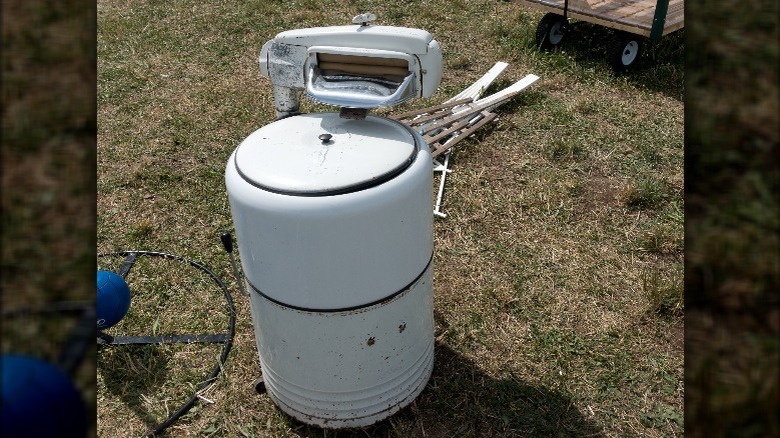The Benefits Of Using A Wringer Washer To Do Your Laundry
We may receive a commission on purchases made from links.
Welcome to the world of wringer washers — a testament to simpler times when elbow grease and sheer determination were the magic formulae for spotless laundry. Much like a particular fashion craze involving bell bottoms and platform shoes, this relic of the past has somehow secured a spot in the modern world. And honestly, why not? Using a wringer washing machine to do your laundry doesn't save you water, detergent, and money on your water bills; it also makes for swifter drying. That's right, folks; the wringer washer is a triple asset, offering a more environmentally friendly, affordable, and efficient approach to garment laundering.
But how does a wringer washer work? This machine combines water, detergent, and good old-fashioned elbow grease to clean your clothes. You fill the tub with water and detergent, manually agitate the clothes in the foamy water, feed them through the wringer, and voilà! Your clothes are clean and considerably less soggy, primed for quicker air-drying. Whether manually operated or electric-powered, your choice of wringer washer should accommodate your laundry load without occupying too much space in your home. You must also consider the construction materials. And if you're thinking about wringer washer maintenance? Well, it's primarily about keeping the parts clean and well-oiled.
Why consider a wringer washer for your laundry?
There are several benefits to integrating a wringer washing machine into your laundry. To kick things off, it's the eco-friendly laundry superhero. You can wash several batches in the same water, starting with the whites and progressing to those dark and super-dirty outfits. That doesn't just save water and cut down on bills. It also leaves you with water for quenching your kitchen garden — talk about redefining dirty laundry. Next up, wring washers are all about minimalism. They require minimal detergent, making your laundry routine greener and more sustainable.
But wait, there's more: practicality. Thanks to the wring washer's rollers, your clothes will come out with significantly less water, leading to quicker drying times. This can be particularly handy for humid climates or during rainy seasons when outdoor drying may not be feasible. Opt for a hand-cranked model, and you'll also get a fantastic, at-home arm workout routine that would make Jane Fonda proud.
With fewer moving parts, chances are low that something can go wrong or wear over time. So you'll save on repairs and replacements. Short on space? Worry less. Some wringer washer models are designed to fit snugly on indoor countertops, while others can stay outside all winter without damage. So, you won't have to sacrifice precious, warm indoor space for this bad boy.
How to choose and maintain a wringer washing machine
Start by deciding between an electric or hand-operated option. An electric model will suffice if you're yearning for the taste of the good old days (without the sweat). In contrast, manually operated models are best suited for off-the-grid lifestyles. Keep an eye out for these relics at yard sales, antique stores, rummage sales, and online marketplaces — just be ready to whip out that wallet. Wringer washing machines come in various shapes and capacities, so choose one that fits your space and laundry needs. Bigger might save you time, but beware, it could turn your laundry day into arm day. But again, you don't want a soapy tsunami in your laundry room.
Regarding construction materials, it's the battle of plastic vs. steel. Steel options, like the WringMaster Clothes Wringer Hand Crank, may be heftier but are built to last, making them perfect for passing down through the generations. On the other hand, Plastic models — the WonderWash Portable Mini Washing Machine, for instance — are lighter on your arms and wallet but may not last as long. But even the strongest laundry machines need a little TLC now and then. For a wringer washer, keep the moving parts well-oiled. And don't forget to clean the rollers — you don't want your clothes emerging dirtier than they went in. Lastly, check for and resolve wear and tear to ensure your machine stays in tip-top shape.


